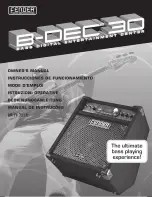
8
p I c k u p I n s t a l l a t I o n
9
p I c k u p I n s t a l l a t I o n
The saddle will then have a slight forward lean when the strings are under tension. It is absolutely necessary
to compensate for this slight lean by sanding a tilt in the bottom of the saddle so it still sits flat on the pickup
when the strings are at tension
(FIGURE 5)
.
If the saddle is too tight, binds at all, or is too loose, this will have a negative effect on the string balance
and output. Set the saddle in the slot, noting how much material must be removed to compensate for the
thickness of the pickup. Sand the bottom surface of the saddle on a belt sander until the scribe line is just
above the bridge top. Finish sanding the bottom by hand. It is best to do this against a machined flat surface
with fine sandpaper. Use a straightedge with a strong light source to inspect the flatness of your saddle.
Insert the pickup all the way into the slot, place the saddle on top of it, and temporarily secure it with a
piece of tape. Secure the wire with a wire clip as close to the exit hole as is practical, with a one- to two-inch
service loop.
Failure to secure the wire may produce boominess and feedback. Restring the guitar, and plug into your
amp or PA. Confirm that the EQ controls are at their default positions and test the Element, paying careful
attention to string balance. If the sound is satisfactory, proceed to the next section. If not, read on.
String balance problems are almost always the result of an uneven interface between the bottom of the
saddle and the saddle slot. If the string balance is uneven, check these surfaces to ensure that they are both
completely flat.
Tip:
A segmented packaging knife blade is useful for determining the flatness of a saddle slot. Break off
enough blade segments so as much of the blade fits into the slot as possible. Briefly use a back-and-forth
scraping motion to see if the slot bottom scrapes evenly. Any high or low spots will be readily apparent. A
minor low spot in the slot may be compensated for by shims under the pickup; however, for gaps over .005”
or multiple gaps, we recommend rerouting the slot.
Slot
Bridge
Drill Bit
Guitar Top
Brace
Figure 4
This view depicts the bridge at an angle level with the guitar top and
perpendicular to the saddle slot. Note the rounded edge where the hole
has been drilled.
Figure 5
Proper saddle / pickup contact
(exaggerated saddle lean)


























